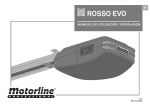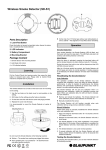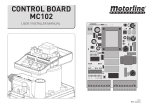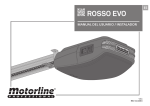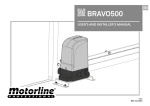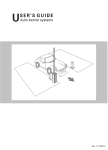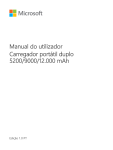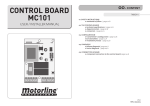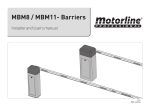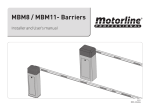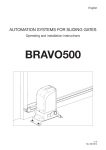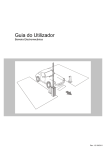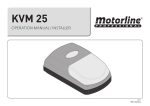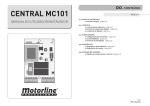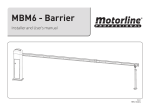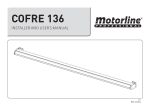Download ROSSO EVO - Set Up Users
Transcript
EN ROSSO EVO USER'S AND INSTALLER'S MANUAL v2.1 REV. 11/2014 00. CONTENT 01. SAFETY INSTRUCTIONS INDEX STANDARDS TO FOLLOW 01. SAFETY INSTRUCTIONS ATTENTION: STANDARDS TO FOLLOW 1B 02. PACKAGE INSIDE THE PACKAGE 2A 03. THE AUTOMATISM TECHNICAL SPECIFICATIONS MANUAL BRAKE RELEASE REMOVE UPPER COVER REPLACE UPPER COVER CHANGING COURTESY LEDS CHANGING FUSE PRE-INSTALLATION INFORMATION 2B 3A 3B 3B 4A 4A 4B 04. INSTALLATION ENGINE’S FIXATION IN THE PIPELINE THE AUTOMATISM INSTALLATION INSTALLATION MAP 5A 5B 7 05. PROGRAMMING LEGEND MENU FUNCTIONS PROGRAMMING TRANSMITTERS 8A 8B 11A 06. POST-INSTALLATION STOPPER AT THE OPENING STRETCH RAIL CHAIN MAINTENANCE • To ensure the safety of people, it is important that you read all the following instructions. Incorrect installation or incorrect use of the product can cause physical injury and material damage. • Keep these instructions in a safe place for future reference. • This product was designed and produced strictly for the use indicated in this manual. Any other use, not expressly indicated here, could compromise the good condition/operation of the product and/or be a source of danger. • ELECTROCELOS SA is not responsible for the improper use of the product, or other use than that for which it was designed. • ELECTROCELOS SA is not responsible if safety standards were not taken into account when installing the equipment, or for any deformation that may occur to it. • ELECTROCELOS SA is not responsible for the safety and proper operation when using components not sold by them. • Do not make any modifications to the operator components and / or their accessories. • Before installation unplug the automatism from the source of power. • The installer must inform the client how to handle the product in case of emergency and provide this manual to user. • Keep remote controls away from children, to prevent the automated system from being activated involuntarily. • The customer shall not, under any circumstances, attempt to repair or tune the operator .Must call qualified technician only. • Connect the automatism to a 230V plug with ground wire. • Operator for indoor use. 11B 12A 12A 07. DIAGNOSIS CONNECTING ENGINE TO 24V BATTERY 12B 08. TROUBLESHOOTING INSTRUCTIONS FOR FINAL CONSUMERS INSTRUCTIONS FOR TECHNICAL PERSONNEL 13 13 09. CENTRAL CONNECTIONS ROSSO EVO CENTRAL 14 EN EN 02. PACKAGE 03. THE AUTOMATISM INSIDE THE PACKAGE TECHNICAL SPECIFICATIONS Inside the package you will find the following components: The ROSSO EVO specifications are as follow: 01• 01 ROSSO EVO motor 02• 01 main rod 03• 01 secondary rod 04• 02 4-channel transmitters 05• 01 transmitter support 06• 01 mounting bracket 07• 01 unlock string 08• 03 motor’s fixing plate to the rail 09• 01 rail’s fixing plate to the ceilling 10• 01 rail’s fixing plate to the lintel 11• 01 gate’s fixing plate 12• 01 reinforcement plate to gate’s fixing plate 13• 01 stopper 14• 01 set of fixing accessories ROSSO EVO 60 ROSSO EVO 100 ROSSO EVO 120 • Power Supply AC 230V 50/60Hz AC 230V 50/60Hz AC 230V 50/60Hz • Motor's Power DC24V - 100W DC24V - 120W DC24V - 160W 140mm /sec 140mm /sec 140mm /sec • Noise Level ≤56dB ≤56dB ≤56dB • Force 600N 1000N 1200N -20°C a 70°C -20°C a 70°C -20°C a 70°C 120°C 120°C 120°C • Protection grade IP20 IP20 IP20 • Working frequence 70% 70% 70% 3 minutes 3 minutes 3 minutes 10m² 15m² 18m² 30 transmitters 30 transmitters 30 transmitters Rolling Code Rolling Code Rolling Code 433,92Hz 433,92Hz 433,92Hz • Velocity • Operating temperature • Thermal protection • Courtesy Light • Maximum door area 11• 01• • Memory 04• • Code Type 12• • Radio frequency The automatism ROSSO EVO dimensions are as follows: 08• 13• 359mm 10• 09• 02• 170mm 03• 06• 07• 24 0m m 01 EN m 450 m 150mm 215mm 137mm 02 EN 03. THE AUTOMATISM 03. THE AUTOMATISM MANUAL BRAKE RELEASE REMOVING TOP COVER The ROSSO EVO unlocking system is very simple and practical to use. To do so just pull the lever down (figure 03). To block simply pull the lever to the original position. 01 05 06 To remove the cover simply insert a small screwdriver into the side holes, and create a leverage effect to release the indents fittings between the top cover and the body. Then just remove the cover by lifting it. 02 03 REPLACE TOP COVER Position 01 • Motor locked Position 02 • Motor unlocked ← Together with the automatism it is also provided a string to apply on the unlock lever, which makes it even a more practical and comfortable process. Maximum: 700mm 07 04 08 To replace the cover you must first fit the back as shown in the figure 07. Then simply turn down the cover and fit the front pressing down. The fittings will automatically secure the cover. EN EN 03. THE AUTOMATISM 04. INSTALLATION CHANGING COURTESY LEDS INFORMATION PRE-INSTALLATION For a correct operation of ROSSO EVO, you must take into account the following parameters before the installation: • Read all steps on this manual at least once in order to get acquainted with the installation and configuration process. • Make sure the door’s structure is solid and appropriate to be automated. • Verify that the sectional door has no technical defects, such as friction points / prison, that may jeopardize the automatism durability. 09 10 • To replace the LED board you must open the top cover and detach the wire of the LED from the control board. Loosen the screw which secures the LED board to the top cover and remove it. Now just put the new LED board, screw it, fit the wire in the control board and close back the cover on the motor. • Make sure the door is in good condition to install the motor. To do so, raise it manually to 800mm, 1600mm and 2000mm from the ground. Check if the door remains suspended in these positions or descending. If the door starts to go up or down, it means that the springs are not well calibrated. • Check the surroundings. Carefully evaluate any hazards that may cause material damage, possible insects contact, infiltration, among others. • Make sure that the automatism will be connected to a 230V, properly protected with Ground Wire. CHANGING FUSE • Make sure there is adequate protection against short-circuits / power surges and earthed in the Electrical Box. • Be careful when handling directly the control board. Improper handling can damage some electrical components. • Make sure you have all the necessary material prepared for installation. • Evaluate the safety devices to be installed. This will ensure that unexpected accidents do not happen. 11 12 • To replace the fuse, first loosen it as visible in the image 11. Then just pull to remove it (image 12). Repeat the same steps in reverse order to put a new fuse. The operator uses a 250V 2,5A. EN It is very important that these precautions are respected! Only in this way the correct functioning and automatism durability can be achieved! EN 04. INSTALLATION 04. INSTALLATION FIXING THE MOTOR IN RAILS AUTOMATISM INSTALLATION With standard rails, you can only automate doors with maximum height of 2400mm. 100-150mm DETAIL 13 125-175mm 15 16 01 • Attach the rail’s support plate to the lintel, as visible in the image 15. In the image 16 if can be seen the distance to keep between the gate rail and support plate’s upper part (125-175mm). 13 ← Note • If you are unable to fix the rail to the ceiling for not respecting the measures above, there should be created a solid structure to be able to fix the motor in correct measurements. This structure may be fixed to the ceiling as a visible on the image 17. CEILLING 01 • The steel rail and automatism attachment must be made using the plates and M6 nuts as shown above. Fasten 4 screws, leaving the two in the middle free. DETAIL 14 17 14 ← Support 02 • The aluminum rail and automatism attachment must be made using the plates and M6 nuts and as shown above. Tighten 4 screws, leaving the two in the front free. EN 18 02 • Fasten the rail in the fixation plate already attached. To facilitate the task, you can do it with the rail inclined (motor on the floor / support) which facilitates the installation since you only have to handle the area of rail to be fixed. EN 04. INSTALLATION 04. INSTALLATION AUTOMATISM INSTALLATION AUTOMATISM INSTALLATION DETAIL 19 19 23 22 03 • Place celling rail ‘s fixation plate roughly halfway through the steel rail as visible in the pictures above. 05 • After rising the rail and mark the holes, you should fix the plate with screws. After that, you should use bracket to reinforce the attachment, this time near the motor (image 23). 04 • Raise up the motor until the rail is levelled horizontally. If necessary, you should create a support structure to a solid surface as shown on the previous page, so that the rail stays horinzotally aligned (picture 17). 01 02 Mark the holes in the ceiling plate and / or structure and make the necessary holes to fix it. 03 04 24 06 • Attach the plates to the top of the door panel. The rods must be centered horizontally with the panel so that it stays aligned with the rail. It should also be to fixed as higher as possible (picture 24). 20 21 EN EN 25 07 • Now attach the two connecting rods between the trolley and the panel’s upper plate. Use the screws and M8 nuts to tighten 2 rods together ( 02 and 03 ), and 2 pins with pegs to fix them on the trolley and the gate ( 01 and 04 ). 04. INSTALLATION INSTALLATION MAP 06 28 02 27 07 10 08 09 26 26 05 02 27 04 03 03 01 28 LEGEND: 01 • ROSSO EVO Motor 02 • Steel rail 03 • Rail to ceilling’s/struture’s fixation plate 04 • Bracket for structure fixing 05 • Fast rail to ceilling’s/struture’s fixation plate 06 • Trolley with unlocking system 07 • Rail to lintel’s fixation plate 08 • Connection arm between trolley and gate 09 • Fixation rod to the gate 10 • Shaft and sectional door springs 29 EN 05. PROGRAMMING 05. PROGRAMMING MENU FUNCTIONS LEGEND Legend: The control board has a main menu which allows access to all the different settings of the automatism. • Display • Main Menu • Programming transmmiters • Up • Down When you turn the power on, the LCD displays a countdown from 99 to 11, and the courtesy lamp stays on for 2 seconds. When the motor is in standby, the display shows the message . When the motor is opening, the display always shows the message When the motor is closing, the display always shows the message . • Programming opening and closing courses • Programming the automatism force level • Enable/disable safety photocells • Programming the self-closing feature • Enable/disable condominium function • Programming maintenance warnings • Programming transmitters using already configured transmitters • Counting of maneuvers • Enable/disable the service door . Note: If you connect a signaling lamp, this will blink during any gate’s movement cycle. Start all the programs from the stand-by mode (--)! All the menu configuration instrution in this manual have been performed using as starting point the stand-by mode (--). Begin programming the P1 menu with the gate closed, since the first maneuver configuration will be the opening. • Programming opening and closing courses Conector Links: 1 • Pedestrian Gate (NC contact) 2 • PB (contact NO) 3 • PE (contact NC) 4 • GND (common) 5 • +24V 6 • Extern Lamp (max. 24V 5W) 3 12 45 01 • Press the M key for 4 seconds to enter the programming menu. 02 • The display will show P1 and press the M key for 2sec to enter the submenu. 03 • The display will show OP and you can now set the opening limit using the or keys to adjust it. 04 • Press the M key for 2sec to confirm the opened position. 05 • The display will show CL and you can now configure the closing limit using the same or keys. 06 • Press the M button for 2sec to confirm the closed position. The control board saves the configuration and exits the programming mode. The LEDs light up for 2sec and the gate starts to open and close automatically to the programmed limits showing the message OP during the opening and CL during the closing. When it finishes closing, the control board will exit to the stand-by mode (--). 6 If it stays more than 20sec without pressing any key, the control board will exit every programming and automatically go to stand-by mode (--) without saving any action. 30 EN EN 05. PROGRAMMING 05. PROGRAMMING MENU FUNCTIONS MENU FUNCTIONS • Programming the automatism force level • Programming the self-closing feature 01 • Press the M key for 4 seconds to enter the programming menu. 02 • The display will show P1 and press and keys repeatedly until it shows P2. 03 • Press the M key once to access this submenu. 04 • The display will show a value between F1 and F9, which identifies the strength level when the motor is configured. Use the or keys to select the desired option, being F1 the minimum force and F9 the maximum. 05 • Press the M key once to save this option. 06 • The control board will exit to standby mode (--) and the configuration is complete. 01 • Press the M button for 4 seconds to enter the programming menu. 02 • The display will show P1 and press and keys repeatedly until it shows P4. 03 • Press the M key once to access this submenu. 04 • The display will show a value between 00 and 90, which identifies the time in seconds that the engine is on hold since the opening ends until start automatic closing. Use the or buttons to select the desired option. 05 • Press the M key once to save this option. 06 • The control board will exit to standby mode (--) and the configuration is complete. Nota • The control board comes with the F4 level configured from the factory. Note • The option 00 disables the automatic closing, so the gate will only close if it receives an order from a configured device. Any other option sets the automatic closing time, being the minimum 10 seconds (option 10) and the maximum 90 seconds (option 90). • Enable/disable safety photocells 01 • Press the M button for 4 seconds to enter the programming menu. 02 • The display will show P1 and press and keys repeatedly until it shows P3. 03 • Press the M key once to access this submenu. 04 • The display will show the value H0 or H1, which identifies the option in which the central is configured. Use the or keys to select the desired option. H0 disables the use of photocells and H1 activates it. 05 • Press the M key once to save this option. 06 • The control board will exit to standby mode (--) and the configuration is complete. Functionality • When the use of photocells is active and some obstacle cross them when the door is closing, the door will reverse direction beginning to open. Note • The use of photocells comes disabled by the factory (H0). Start all programs from the stand-by mode (-) • Enable/disable function condominium 01 • Press the M button for 4 seconds to enter the programming menu. 02 • The display will show P1 and press and keys repeatedly until it shows P5. 03 • Press the M key once to access this submenu. 04 • The display will show the value H0 or H1, which identifies the option in which the central is configured. Use the or buttons to select the desired option. 05 • Press the M key once to save this option. 06 • The control board will exit to standby mode (--) and the configuration is complete. Functionality • This function causes the central to ignore all orders for the opening course sent by configured devices. • If you press the transmitter during the opening, the order is rejected and it continues to open • If you press with the door completely open, it will begin to close. • If you press during closing, the gate reverses direction and starts to open. When disabled, you can control the opening or closing of the gate whenever you want, and their behavior is open-stop-close-stop-open (...) by each time you press the transmitter. If it stays more than 20sec without pressing any key, the controlboard will exit the state and will automatically go to stand-by mode without saving any action. EN Note • The P4 and P5 functions, when activated, prevent the gate to stay open. This way the gate will always open completely, starting the closure after the pause time defined in P4. EN 05. PROGRAMMING 05. PROGRAMMING MENU FUNCTIONS MENU FUNCTIONS • Programming maintenance warnings • Counting maneuvers 01 • Press the M key for 4 seconds to enter the programming menu. 02 • The display will show P1 and press and keys repeatedly until it shows P6. 03 • Press the M key once to access this submenu. 04 • The display will show a value between 00 and 45, which identifies the thousands of maneuvers to which the motor will emit a warning maintenance light. Use the or keys to put on the desired option. 05 • Press the M key once to save this option. 06 • The control board will exit to standby mode (--) and the configuration is complete. Funcionality • This notice serves to schedule revisions to the automatism, gate or springs after a certain number of complete maneuvers (open-stop-close-stop). When the automatismo completes the number of maneuvers defined by this menu, the LEDs will blink during 2 minutes after every maneuver, to emit the maintenance warning. Note • The option 00 disables the maintenance warning. Any other option defines thousands of operations, the lowest value is 5000 operations (option 05) and the maximum is 45000 operations (option 45). Whenever you want to reconfigure this option, you must perform two configurations. First, set the option to 00 to make a RESET to the counting maneuvers. After that, make a new one setting the new desired option. The central will, from this moment on, start counting maneuvers to emit the maintenance warning. • Programming transmitters using already configured transmitters 01 • Press the M key for 4 seconds to enter the programming menu. 02 • The display will show P1 and press and keys repeatedly until it shows P7. 03 • Press the M key once to access this submenu. 04 • The display will show the value L0 or L1, which identifies the option in which the central is configured. Use the or keys to put on the desired option. 05 • Press the M key once to save this option. 06 • The control board will exit to standby mode (--) and the configuration is complete. Funcionality • This menu allows you to enable or disable the possibility to program a new transmitter through one already configured (see page 11.A). L0 means that this functionality is disabled, and L1 means that is enabled. EN 01 • Press the M key for 4 seconds to enter the programming menu. 02 • The display will show P1 and press and keys repeatedly until it shows P8. 03 • Press the M key once to access this submenu. 04 • The display will show three numbers, each one for 2 seconds separated by intervals of 1 second between them. After this the control board will automatically exit to standby mode (--). Funcionality • This function serves only to show all completed maneuvers performed by the automatism (open-stop-close-stop). Just put together the three numbers shown on the display and you will know the total maneuvers of that engine. Example: If when entering the P8 submenu the display first show nº15, then nº65 and finally nº22, means that a total of 156522 complete maneuvers have already been done. RESET through the menu P6: To restart maneuver counting, go to P6 submenu, and while the display shows any of the options in this submenu, press the and keys simultaneously for 10seconds. The control board will automatically exit to standby mode and the RESET to the P8 menu is complete. • Enable / disable the service door 01 • Press the M key for 4 seconds to enter the programming menu. 02 • The display will show P1 and press and keys repeatedly until it shows P9. 03 • Press the M key once to access this submenu. 04 • The display will show the value E0 or E1, which identifies the option in which the central is configured. Use the or keys to put on the desired option. 05 • Press the M key once to save this option. 06 • The control board will exit to standby mode (--) and the configuration is complete. Funcionality • The E0 disables the use of the service door while the E1 option activates it. When activated this function, the controlboard will only make any opening or closing maneuver if the service door is closed. If the door is opened, the controlboard will reject any opening or closing order. EN 05. PROGRAMMING 06. POST-INSTALLATION PROGRAMMING TRANSMITTERS 1 2 1 4 4 STOPPER AT THE OPENING 2 3 The automatism needs a stopper in the opening and closing to always control the courses. In closing maneuvers, the ground will be the stopper for the gate, but in the opening maneuvers it is necessary to create a stopper on the steel rail, to ensure that the trolley always stop in the correct place. 1 2 3 4 3 [MX4SP] 31 [MXS4SP] 32 33 [MX5SP] • Standard configuration using the T key on the display 01 • In stand-by mode (--) press the T key until the display shows SU. 02 • Press one time the transmitter’s desired key to configure until the engine starts moving. Note • Repeat these steps whenever you want to configure new transmitters. 34 35 • Configuration through already configured transmitters Since there is already configured transmitter, you can use it to open the control board’s memory by distance in order to configure new transmitters. This allows easy configuration without requiring direct access to the engine. 01 • In Stand-By mode (--) press 2 and 3 keys from an already configured transmitter until the courtesy LEDs start to blink. Now release the pressed buttons. 02 • Press the new transmitter’s desired key to configure until the automatism starts moving. Note .1 • Repeat these steps whenever you want to configure new transmitters. Note .2 • This feature can be enabled or disabled via the P7 menu (see pag 10.A). • Delete all configured transmitters 36 • To install the opening stopper just apply it on the rail, as seen in Figure 34. The stopper must have a metal plate out of the rail and other on the inside, so when you fasten it, this is secure in the pipeline. • With the door completely open, push the stopper untill it touches the trolley (35). • Fasten the two screws to hold the stopper in that exact position (36). 01 • In stand-by mode (--) press the T key for 10sec until the display shows dl. The control board has a maximum capacity of 30 transmitters and only accepts Motorline Rolling Code transmitters! EN EN 06. POST-INSTALLATION 07. DIAGNOSIS STRETCH RAIL’S CHAIN CONNECT ENGINE TO 24V BATTERY DETAIL 39 37 For a correct automatism function, the chain has to be very well adjusted. For that, you just need to tighten or loosen the shadowed nut in the above picture with a wrench key, which will stretch or relieve the chain. The chain can’t be too much stretched, or it will get too stuck and damage the gear and the motor, nor too loose to the point of creating a sag in the middle and come out of the rail. Note • The spring tensioner should never get fully compressed, because it means that it is on is maximum tension! 39 In case of automatism failure or malfunction, you must detect the fail component (motor or central). To do that, you should test the motor directly connected to a 12/24V DC power source, in order to understand if this works. Just disconnect the two motor cables (shaded in the image 39) which connect to the central and connect them directly to a 12/24V DC battery as visible in the image 40. MAINTENANCE 40 38 The only maintenance required is lubricating the automatism and rail motion axes. The pinions at both ends of the rails as well as their supporting bearings and chain should be lubricated at least once every year. EN Motor cables have no specific way of connection. The only difference is that if you connect the motor in one way, it will rotate in one direction, and if you connect the wires in the oppose it will rotate in the other direction. EN 08. TROUBLESHOOTING INSTRUCTIONS FOR FINAL CONSUMERS Anomaly • Motor does not work • Motor does not move but makes noise Procedure Actions INSTRUCTIONS FOR TECHNICAL PERSONNEL Procedure II Discovering the origin of the problem 1 • Remove the top cover of the engine; 2 • Measure the 24V transformer’s output to detect the location of the malfunction; A) Has 24V: 1 • Make sure the central is supplying the motor to detect whether the fault is in the engine or in the central. Replace the damaged component or send to Motorline facilities for diagnosis and repair. • Consult a MOTORLINE qualified technician. 1 • Give a start on the transmitter to open and check the LEDs behavior. 2 • If it blinks twice, then the connection with the photocells is having problems. Check all the photocells circuit connection. 3 • If it flashes three times, then the service door connection is having problems. Check all the door’s connection circuit. • Encountered any problems? • Consult an gate’s technician. 1 • Check all the motion axes and the movement systems associated to the gate and the automatism (rails,pulleys, bolts, hinges, etc.) to find out he problem. Also make sure the springs are in good condition and are able to withstand the gate. • The gate moves easily? • Consult a MOTORLINE qualified technician. 1 • Turn off the central’s motor and test it directly connected to a 24V battery to find the malfunction (see page 12.B) • Consult a MOTORLINE qualified technician. 1 • Make sure the display and the courtesy LEDs are connected and to see if it has power; 2 • Go to the menu on the display and disable the photocells and the service door; 3 • Try to close; • Verify that you have connected to 230V power to the automation and if the fuse is working properly. • Still not working • Make sure the pedestrian service door is securely closed. • Still not working • Unlock the engine and move the gate manually to check for mechanical problems on the gate. • Motor opens 1 • Check if there is • Gate has opened but does not any obstacle in front but did not close. close of the photocells; 2 • Check if any of the gate’s control devices (key selector, push button, video intercom, etc.) are locked and sending permanent sign; • Consult a MOTORLINE qualified technician. 2 • If the engine operate, the problem is in the central. Pull it out and send it to the MOTORLINE technical services for diagnosis; B) Doesn’t have 24V: 1 • Check the 230V transformer input. If you can measure 230V on the input, the transformer is the problem. If not, the problem is the fuse, electrical cables or electrical current itself. Check all systems. 3 • If the motor does not work, remove it and send it to the MOTORLINE technical services for diagnosis. A) It closed: 1 • Problem is in one of these two systems. Activate the photocells and make sure the gate closes. If it closes, the problem will be on the service door. Activate it from the menu and try to close the gate to be sure. B) Didn’t close: 1 • The problem is in the motor or in the central.Give the order to close the gate while measuring the output power from the central to the engine. If you have 24V, the center is working and the problem is in the engine. 2 • If it does not have power, the problem remains in the centralboard. NOTE • With the gate open, if you give the order to close and you have some obstacle in front of the the photocells, LEDs blink twice. During closing, if it invert for stress detection, blink once. • Motor does not the full itinerary • Unlock motor and move gate by hand to check for mechanical problems on the gate. • Encountered any problems? • Consult an gate’s technician. 1 • Check all the motion axes and the movement systems associated to the gate and the automatism (rails,pulleys, bolts, hinges, etc.) to find out he problem. Also make sure the springs are in good condition and are able to withstand the gate. • Is the gate moving easily? • Consult a MOTORLINE qualified technician. 1 • Verify that the gate tests were well done; 2 • Change the force on P2 menu until the engine move the gate without changing direction; 3 • This adjustment must be made so that the gate when meeting an obstacle inverts his direction (left illustration); 4 • If even at his maximum strength (F9) the problem still remains, test the motor directly connected to a 24V battery to see if it has the strength to open/ close the door completely; 5 • Change the force on P2 menu until the engine moves the gate without changing direction; EN 09. CENTRAL CONNECTIONS ROSSO EVO CONTROL BOARD Pedestrian Door Pushbutton/Key Selector Photocells DV 12/24V COM NC Lightbulb DV 12/24V or ~ ~ ~ ~ 24V 5W máx External Receiver 12/24v 0v CH1-a CH1-b CH2-a CH2-b Outdoor Antenna MR5 Courtesy LEDs 4 5 6 1 2 3 230V Power Supply CON1* Battery 12/24V GND Recetora 433,92Hz ANT Encoder 1 2 DISPLAY BOARD CONTROL BOARD Transformer IN:230V OUT:24V Fuse 2.5AL 250V Earth wire MOTOR (máx 240W) *CON1: 1 • Pedestrian door 2 • PB 3 • PE 4 • GND 5 • +24V (máx: 1,5W) 6 • FLASH (máx: 24V 5W) 41 EN
















